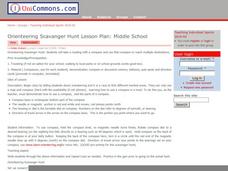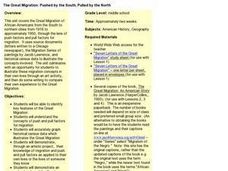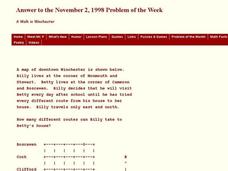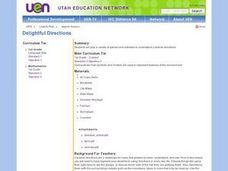National Endowment for the Humanities
Factory vs. Plantation in the North and South
North is to factory as South is to plantation—the perfect analogy for the economy that set up the Civil War! The first lesson in a series of five helps teach beginners why the economy creates a driving force for conflict. Analysis of...
Curated OER
Chapter 3 Test: Civil War
Although specific to a certain book, this test and review relating to the Civil War could used in any classroom. The questions asked are appropriate for students learning about this era in U.S. History. Questions could be altered, or...
Curated OER
Pirate Treasure Hunt
First graders name the directions North, South, East, and West on a map. They work collaboratively in small groups and create a treasure map using directions as clues.
Curated OER
Orienteering Scavenger Hunt Lesson Plan: Middle School
First, teach your class how to read a compass, and then do the scavenger hunt. This is rather a nice little activity to do. It can be done as part of a unit on orienteering or just for the fun of it as a stand-alone instructional...
Curated OER
U.S. History Worksheet #72
Why did the North win the war? In this United States history worksheet, students utilize a word bank of 10 terms or phrases to answer 10 fill in the blank questions pertaining to the Civil War. A short answer question is included as...
Curated OER
Create a Migrant's Scrapbook from the First Great Migration
Help young historians personally engage in the stories of African Americans during the Great Migration! Assessing a migration route map, learners create a migrant character's experience, adding details while studying primary sources. A...
Curated OER
What Were the Political & Social Views of People During the Civil War
Eighth graders study the Civil War. In this US history lesson, 8th graders discuss the causes for fighting for the North and the South showing that there was no good side or evil side just people believing in what they were fighting for....
Curated OER
Cardinal Directions
First graders study cardinal directions on maps. In this geography lesson, 1st graders determine and show where North, South, East, and West are on various maps.
Curated OER
Civil War
Students are be able to analyze primary sources (Civil War images) for examples of how soldiers are portrayed historically. They discuss what a hero is and why some individuals are heroes to certain groups while others are not.
Curated OER
The Great Migration: Pushed By The South, Pulled By The North
Students identify key features of the Great Migration. They explain the concepts of push and pull factors for migration. They create an art project which shows an understanding of the push and pull factors.
Curated OER
All About the Animals
Whose footprints are those? After reading Janet Halfmann's book, Little Skink's Tail, young scholars use footprints to determine where on a gridded map certain animals have been spotted. They use the map to answer 3 questions, one...
Curated OER
Free Blacks in the North and in the South
Eleventh graders research the different lives of free blacks in the South and the North. For this Post Civil War lesson, 11th graders analyze primary sources that illustrate their lives. Students create posters that compare and contrast...
Curated OER
A Walk in Winchester
In this Winchester instructional activity, students determine the number of different routes to a determined location. This one-page instructional activity contains 1 problem. The answer is provided at the bottom of the page.
Curated OER
Four Main Directions
Students describe directions using a globe for north, east, south and west. For this mapping lesson students identify the north and south pole. Students understand the importance of the equator and the Prime Meridian. Students explain...
Curated OER
Latitude Longitude
In this latitude and longitude learning exercise, students place a dot on a graph that represents each latitude and longitude location given. The learning exercise has 46 locations to graph.
Curated OER
Latitude Longitude
In this latitude and longitude activity, students plot 39 latitude/longitude locations on a graph, connecting the dots as they go along.
Curated OER
Latitude Longitude
In this latitude and longitude worksheet, students plot 34 latitude/longitude locations onto a graph, connecting the dots as they go along.
Curated OER
Writing Vectors
In this vectors worksheet, students draw 15 vectors using a given key with direction and measurement. Students are given a specific distance and direction for each vector to draw.
Curated OER
VS.7a
Seventh graders explore, analyze and identify the events and differences between northern and southern states that divided Virginians and led to secession, war and the creation on West Virginia. They discuss the conflicts that developed...
Curated OER
The Economic Differences Between the North and the South Prior to the Civil War
Seventh graders identify and explain the economic differences between the North and the South incorporating photographs and a Venn Diagram to interpret the two sides. They complete a KWL and T-chart to assist them with their task for the...
Curated OER
Delightful Directions
First graders identify and demonstrate how symbols and models are used to represent features of the environment. They identify the directions on a map as east, west, north, and south. Finally, 1st graders play a direction game, move to...
Curated OER
WEEK TWO
Students research in books and on the Internet on the Underground Railroad. They work on a constructivist project to promote both group collaboration and individual creativity. Students are given an authentic task: to create a museum...
Curated OER
That's NorthEastWestSouth to Me!
Students demonstrate north, south, east and west. In groups, students participate in games to decide what directions a specific bear must travel. They play a "Simon Says" game to develop single step directions. Students listen to and...
Curated OER
North or South? Which has a better way of life?
Sixth graders brainstorm what they believe are the causes of the Civil War. They copy the blank circle graph into their Social Studies journals twice once for their prediction and once for the actual. Students list the following...

























